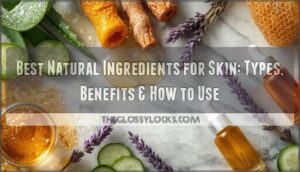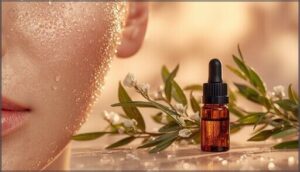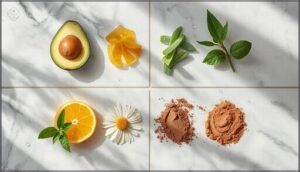This site is supported by our readers. We may earn a commission, at no cost to you, if you purchase through links.
Your skin absorbs up to 60% of what you put on it, which means the ingredients in your products don’t just sit on the surface—they work their way into your body. That’s why understanding the best natural ingredients for skin matters more than choosing between brand names or trendy packaging.
Natural ingredients from plants, minerals, and oils offer measurable benefits without the synthetic additives that can trigger irritation or long-term concerns. The right ingredients can transform how your skin looks and feels, whether you’re dealing with dryness, breakouts, sensitivity, or signs of aging.
Once you know which natural ingredients work for your specific skin type and concerns, you can build a routine that actually shows results.
Table Of Contents
Key Takeaways
- Natural ingredients like coconut oil, aloe vera, and tea tree oil deliver clinically proven results—coconut oil improves skin moisture by 148.89% in four weeks, while tea tree oil reduces acne lesions by 55% in six weeks.
- Your skin absorbs up to 60% of what you apply, making ingredient selection critical since many “natural” labels aren’t regulated—look for certifications like COSMOS or USDA Organic to verify authenticity.
- Matching ingredients to your skin type matters more than brand names: dry skin needs avocado and shea butter for barrier repair, oily skin responds to witch hazel and clay, sensitive skin calms with jojoba and cucumber, and aging skin firms with argan oil and vitamin C.
- Natural ingredients work with your skin’s biology by providing antioxidant protection, supporting collagen production, and reducing inflammation without the synthetic additives that trigger irritation or long-term health concerns.
What Makes an Ingredient “Natural” for Skin
You’ve probably seen “natural” plastered across countless skincare labels, but that term doesn’t mean the same thing to everyone. The beauty industry isn’t tightly regulated, so it’s easy to find products marketed as natural that still contain synthetic additives or harsh chemicals.
Understanding what truly qualifies as a natural ingredient—and what to watch out for—helps you make smarter, safer choices for your skin.
Definition of Natural Skin Care Ingredients
Natural skin care ingredients come directly from plants, minerals, or marine sources—not petrochemicals. To earn certification, products must meet strict standards: at least 95% of agricultural ingredients should be naturally derived, with processing methods like cold-pressing that keep their molecular structure intact.
However, “natural” labels aren’t always regulated, so some products contain synthetic additives. You’ll want to look for trusted certifications that guarantee true ingredient sourcing and regulatory compliance.
Consumers often seek natural skin alternatives due to concerns about synthetic chemicals.
Common Sources: Plants, Minerals, and Oils
Now that you understand what qualifies as natural, let’s explore where these ingredients actually come from. The most trusted natural ingredients for skin fall into three main categories:
- Plant extracts from herbs, flowers, and roots (like aloe vera and calendula)
- Mineral pigments such as zinc oxide and iron oxides for protection
- Organic oils from nuts and seeds, especially cold-pressed varieties
- Botanical butters like shea, providing rich hydration
- Marine sources including algae with powerful moisturizing properties
Many find that hyaluronic acid benefits skin elasticity. Ethical sourcing ensures these ingredients benefit both your skin and the environment.
How to Identify Truly Natural Ingredients
Reading labels helps you spot authentic natural skin care ingredients, but it’s not always straightforward. Start by checking the first three items listed—they make up most of the formula. Look for certification marks like COSMOS or EcoCert on packaging, which verify genuinely organic ingredients. Use ingredient analyzers to decode unfamiliar names and watch for greenwashing prevalence, since studies show 58% of “natural” products contain synthetic additives despite their label claims.
| What to Check | Why It Matters |
|---|---|
| Top 3 ingredients | Usually 60–80% of the formula |
| Certification seals | Verified by third-party audits |
| Ingredient dictionary tools | Reveals hidden synthetic compounds |
Ingredients to Avoid in Conventional Products
Once you know what to look for, it’s equally important to know what you shouldn’t put on your skin. Parabens pose dangers such as endocrine disruption and possible links to breast cancer, while phthalates have effects involving reproductive toxicity. Sulfates can cause irritation, leading to redness and barrier damage, and formaldehyde carries risks, including cancer concerns. Synthetic fragrances trigger allergies in 1–3% of people, making these harmful ingredients in beauty products worth avoiding entirely.
Top Natural Ingredients for Healthy Skin
Nature offers some of the most effective ingredients for maintaining healthy, balanced skin. These plant-based oils, botanicals, and minerals work with your skin’s natural processes rather than against them.
Below, you’ll find seven ingredients that have earned their place in both traditional remedies and modern skincare routines.
Coconut Oil for Moisturization
Coconut oil ranks among the most effective natural skin care ingredients for moisturization, backed by clinical evidence showing a 148.89% improvement in skin moisture after just four weeks of daily use. You’ll also experience TEWL reduction—meaning your skin barrier strengthens and holds water better—with studies documenting a 36.97% decrease in transepidermal water loss. This epidermal strengthening translates to real texture improvement, with users reporting an 180.6% boost in perceived smoothness.
The coconut oil market growth reflects these benefits, projected to reach $6.7 billion by 2035. For those managing dermatological conditions, virgin coconut oil delivers impressive SCORAD reduction, outperforming mineral oil with a 68.23% improvement in symptom severity.
These natural ingredients offer measurable benefits for your skin moisturization routine.
Aloe Vera for Soothing and Healing
Aloe vera stands out among natural skin care ingredients for its proven soothing and healing abilities. You’ll see accelerated burn wound healing and psoriasis relief with twice-daily application over 4–8 weeks, supported by clinical trial data.
The plant’s anti-inflammation properties reduce redness and swelling while improving skin hydration through enhanced moisture retention.
Complementary scar reduction and wound recovery rates consistently outperform standard treatments in randomized studies.
Tea Tree Oil for Acne and Blemishes
For acne-prone and oily skin types, tea tree oil delivers antiinflammatory effects that rival 5% benzoyl peroxide in controlled trials. Its antibacterial action targets Cutibacterium acnes directly, making it an evidence-based acne treatment.
You’ll see reduced lesion counts with proper TTO concentration (most often 5–10%), and application methods matter—dilute it to minimize adverse reactions. Synergistic ingredients like aloe boost tolerability.
Preventative measures include patch testing before full application.
Raw Honey for Antibacterial Benefits
Raw honey brings antibacterial effects that inhibit acne bacteria like C. acnes, supporting both wound healing and skin infection reduction. Its antimicrobial properties offer gentle acne treatment while providing natural skin soothing through reduced inflammation at application sites.
Clinical research shows decreased redness and pustule formation when you apply honey topically. You’ll benefit from improved hydration without added irritation risk, making it suitable for sensitive types.
Jojoba Oil for Balancing Skin
Jojoba oil mimics your skin’s own sebum, making it a smart choice for balancing hydration levels without clogging pores. This natural skin care oil benefits oily skin by regulating moisture, while its vitamin E and antioxidants deliver a collagen boost.
Here’s what jojoba oil does for you:
- Retains water through long- and short-chain fatty acids
- Improves skin elasticity and minimizes fine lines
- Fades stretch marks through enhanced collagen formation
- Provides sunburn relief with anti-inflammatory properties
- Soothes irritation without triggering acne lesions
Research confirms this oil composition aids scar reduction effectively.
Shea Butter for Deep Hydration
When your skin feels tight and flaky, shea butter steps in as one of the most powerful natural ingredients for dry skin. This emollient delivers deep hydration and moisturization by locking in moisture, reducing redness and irritation that often accompanies eczema.
Shea butter benefits include scar reduction and improved skin texture. For best results, warm a small amount between your palms before applying to problem areas.
Apple Cider Vinegar for Clarifying Skin
Beyond locking in moisture, you’ll want natural ingredients that balance your complexion. Apple cider vinegar clarifies skin by restoring proper skin pH levels, which helps control oil and reduce acne-prone skin flare-ups. ACV benefits include gentle exfoliation and pore refinement when diluted correctly.
Understanding ACV risks prevents irritation—always dilute before applying.
Try these dilution methods for safe DIY toners:
- Mix 1 part ACV with 4 parts water for oily skin
- Use 1:8 ratio for sensitive skin
- Apply with cotton pad after cleansing
- Start twice weekly to assess tolerance
- Store in dark glass bottles
Best Natural Ingredients by Skin Type
Your skin type plays a major role in determining which natural ingredients will work best for you. What soothes dry skin might overwhelm oily skin, and what clears acne-prone skin could irritate sensitive complexions.
Here’s how to match the right natural ingredients to your specific skin needs.
Dry Skin: Avocado, Shea Butter, Almond Oil
When your face feels tight and flaky, you’re dealing with a skin barrier that’s lost its lipid content. Avocado, shea butter, and almond oil are natural ingredients for dry skin that restore hydration levels through oil absorption—studies show almond oil boosts moisture by roughly 18% after two weeks.
These product combinations work because they’re packed with emollients that lock water into thirsty skin.
Oily and Acne-Prone Skin: Tea Tree, Witch Hazel, Clay
When breakouts seem endless, tea tree oil, witch hazel, and kaolin clay target the root causes—excess sebum and bacteria. Tea tree benefits include a 72% drop in inflamed lesions after 45 days, while witch hazel uses extend to shrinking visible pores.
Clay mask types pull impurities from oily acne-prone skin without harsh chemicals, giving you natural astringents that actually work.
Sensitive Skin: Aloe Vera, Cucumber, Jojoba Oil
If redness and stinging rule your complexion, aloe vera, cucumber, and jojoba oil restore calm with barrier-supporting ingredients. Aloe benefits include meaningful reductions in skin reactions and faster recovery from irritation, while cucumber hydration visibly cools reactive areas.
Jojoba uses range from anti-inflammatory action—dropping cytokine levels by 30%—to collagen support, making gentle formulations a lifeline for sensitive skin without sacrificing effectiveness.
Aging Skin: Argan Oil, Vitamin C, Beeswax
When fine lines and skin elasticity concerns appear, argan oil, vitamin C, and beeswax form a potent antiaging skincare trio. Argan oil benefits mature skin by improving elasticity parameters and boosting vitamin E levels, while vitamin C aids collagen synthesis and reduces visible wrinkle depth.
Natural antiaging ingredients like these address photoaging without harsh chemicals, giving you effective, gentle care.
Benefits of Using Natural Skin Ingredients
Natural ingredients aren’t just gentler on your skin—they deliver real, measurable results that go beyond surface-level improvements. From locking in moisture to defending against daily environmental stressors, these plant-based compounds work with your skin’s natural biology rather than against it.
Natural ingredients work with your skin’s biology to deliver real results, from deep hydration to protection against environmental damage
Let’s look at the specific ways natural ingredients can transform your skin’s health and appearance.
Hydration and Moisturization
Your skin acts like a barrier, and keeping it hydrated makes all the difference. Natural skincare ingredients like marine phytoplankton deliver essential fatty acids that improve skin hydration and moisture retention.
Aloe vera boosts epidermal moisture content by around 20%, while coconut oil reduces transepidermal loss, which helps your skin stay smoother.
Understanding humectants vs. occlusives lets you choose ingredients that deliver clinical improvements in moisturizing your complexion.
Reducing Inflammation and Redness
When inflammation flares, natural ingredients step in with clinically backed relief. Chamomile benefits include apigenin that reduced dermatitis symptoms in 79% of patients, while ginseng toners calm visible skin redness thanks to anti-inflammatory saponins. Neem oil disrupts inflammatory cytokines, soothing irritated skin and improving acne recovery.
- Chamomile’s apigenin reduces swelling in psoriasis and dermatitis
- Ginseng toners diminish redness through anti-inflammatory compounds
- Neem oil targets cytokines, easing facial erythema
- Essential oils like lavender limit reactive oxygen species
- Centella trials show 68% reduction in irritation-induced redness
Antioxidant Protection Against Environmental Damage
Your skin faces daily assault from UV rays, pollution, and oxidative stress—but plant-based antioxidants offer proven defense. Oregano and clove oils boost cellular antioxidant status by 32%, while ginseng saponins neutralize free radicals that accelerate aging.
Natural vitamin C from plant extracts eliminates 82% of UV-induced reactive oxygen species, strengthening your pollution skin barrier and supporting environmental stress mitigation through measurable UV damage repair.
Supporting Collagen and Skin Elasticity
Pearl extract stimulates collagen production through conchiolin protein, firming skin and reducing fine lines. Ginseng formulations boost fibroblast activity, while marine plankton delivers bioactive peptides that improve skin elasticity.
Thyme & Sage inhibit collagenase, protecting your collagen network from breaking down.
Natural antiaging ingredients rich in amino acids support dermal synthesis, giving you visibly firmer skin with genuine antiaging properties you can measure.
Minimizing Breakouts and Irritation
Acne-causing bacteria don’t stand a chance against tea tree oil, which cuts inflammatory acne lesions by 55% within six weeks. Neem oil disrupts Propionibacterium acnes directly, calming acne-prone skin and reducing breakout frequency you’d otherwise struggle with.
- Tea tree oil reduces inflammatory acne lesions by 55% in six weeks
- Neem oil’s antibacterial compounds lower acne severity in treatment groups
- High-fiber, plant-based diets correlate with fewer acne breakouts through improved gut health
- Omega-3 fatty acids decrease sebum production by up to 35%
- Aloe vera minimizes post-inflammatory care needs and skin irritation after breakouts
Tips for Incorporating Natural Ingredients Into Your Routine
You don’t need to overhaul your entire routine overnight to start using natural ingredients. Whether you’re mixing up treatments at home, shopping for cleaner products, or thinking about where your ingredients come from, small shifts can make a real difference.
Here’s how to bring natural skin care into your daily life in a way that actually works for you.
DIY and Homemade Skin Care Recipes
You’ll find hundreds of recipes online that promise radiant skin, and many use homemade scrubs, facial masks, and accessible natural ingredients like honey or oats. While customization benefits appeal to 55% of users, contamination risks remain high—95% of DIY formulas lack preservatives, inviting bacterial growth. Without proper ingredient sourcing or recipe efficacy testing, you’re better off approaching DIY safety with caution.
| Common DIY Ingredient | Primary Benefit |
|---|---|
| Raw Honey | Antibacterial, moisturizing |
| Oats | Gentle exfoliation |
| Coconut Oil | Deep hydration |
Choosing Clean and Organic Brands
If you’re ready to skip the DIY guesswork, selecting clean skincare products starts with brand certifications—look for COSMOS, USDA Organic, or MADE SAFE logos that confirm ingredient transparency and ethical sourcing.
In 2024, 59% of consumers preferred natural skincare ingredients, and with good reason: certified organic skincare brands offer rigorous testing, sustainable packaging, and the benefits of organic skincare without the trial-and-error risks. Consumer education matters here.
Sustainable and Ethical Sourcing Considerations
When you choose brands with Fair Trade or USDA Certified Organic labels, you’re supporting traceability practices that verify sustainable sourcing from farm to bottle. Consumer demand now drives regulatory influence—over 40% of shoppers prioritize sustainable ingredients with proven environmental impact standards.
Look for cruelty-free certifications and brands partnering with organic sources that document biodiversity protection and fair labor throughout their supply chains.
Frequently Asked Questions (FAQs)
Can natural ingredients cause allergic reactions or sensitivity?
Yes, natural ingredients can trigger allergic reactions or sensitivity. Botanical extracts, essential oils, and fragrance components from plants are common allergens that may cause contact dermatitis, even in products marketed as gentle or clean.
How long do natural skincare products typically last?
Most natural skin care products last three to twelve months after opening, while conventional formulas stretch to two years. Expiration factors like preservation methods and storage practices determine shelf-life—refrigeration and opaque packaging extend freshness considerably.
Are natural ingredients effective for treating hyperpigmentation?
Several natural ingredients show clinical trial evidence for treating dark spots. Niacinamide, vitamin C, azelaic acid, soy, and licorice demonstrated skin brightening benefits with good safety and tolerability, though long-term results need more study.
Do natural ingredients work as well as synthetic ones?
Here’s the thing: both natural ingredients and synthetic ones can work beautifully when formulated well.
Safety profiles, efficacy comparison, and ingredient stability matter more than origin—your skin reacts to quality, concentration, and proper application.
Conclusion
Think of your skin as a garden—what you feed it determines what grows. When you choose the best natural ingredients for skin, you’re planting seeds that yield real, visible results over time.
You don’t need a complicated regimen filled with unpronounceable chemicals. Start with one or two ingredients that match your skin type, observe how your skin responds, and build from there.
Your skin will show you what works when you give it the right nourishment.
- https://www.nsf.org/news/consumers-consider-personal-care-organic-ingredients-important
- https://www.grandviewresearch.com/industry-analysis/organic-skin-care-market
- https://www.cas.org/resources/cas-insights/the-rise-of-natural-ingredients-for-cosmetics
- https://market.us/report/organic-skin-care-market/
- https://www.persistencemarketresearch.com/market-research/natural-and-organic-personal-care-market.asp














